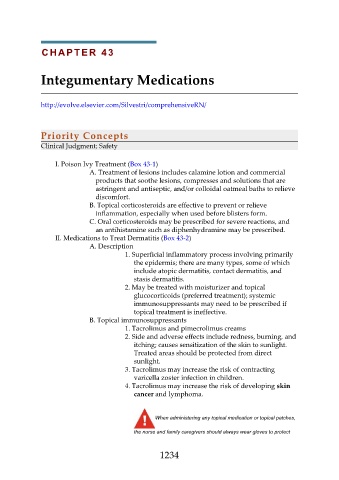Page 1234 - Saunders Comprehensive Review For NCLEX-RN
P. 1234
CHAPTER 43
Integumentary Medications
http://evolve.elsevier.com/Silvestri/comprehensiveRN/
Priority Concepts
Clinical Judgment; Safety
I. Poison Ivy Treatment (Box 43-1)
A. Treatment of lesions includes calamine lotion and commercial
products that soothe lesions, compresses and solutions that are
astringent and antiseptic, and/or colloidal oatmeal baths to relieve
discomfort.
B. Topical corticosteroids are effective to prevent or relieve
inflammation, especially when used before blisters form.
C. Oral corticosteroids may be prescribed for severe reactions, and
an antihistamine such as diphenhydramine may be prescribed.
II. Medications to Treat Dermatitis (Box 43-2)
A. Description
1. Superficial inflammatory process involving primarily
the epidermis; there are many types, some of which
include atopic dermatitis, contact dermatitis, and
stasis dermatitis.
2. May be treated with moisturizer and topical
glucocorticoids (preferred treatment); systemic
immunosuppressants may need to be prescribed if
topical treatment is ineffective.
B. Topical immunosuppressants
1. Tacrolimus and pimecrolimus creams
2. Side and adverse effects include redness, burning, and
itching; causes sensitization of the skin to sunlight.
Treated areas should be protected from direct
sunlight.
3. Tacrolimus may increase the risk of contracting
varicella zoster infection in children.
4. Tacrolimus may increase the risk of developing skin
cancer and lymphoma.
When administering any topical medication or topical patches,
the nurse and family caregivers should always wear gloves to protect
1234

